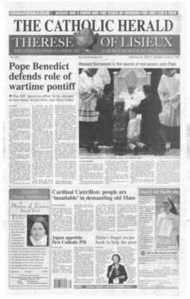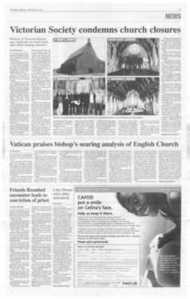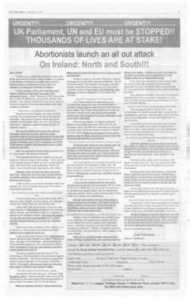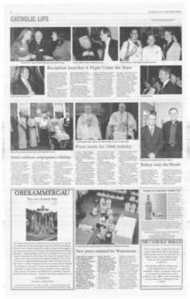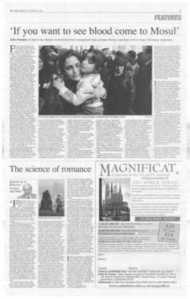Page 3, 26th September 2008
Page 3

Report an error
Noticed an error on this page?If you've noticed an error in this article please click here to report it.
Tags
Share
Related articles
Hold On To Our Heritage
How To Save Your Church From Closure
Shrines To The Sacraments
Rescuing Churches In Crisis
The Fate Of Our Most Beautiful Churches 'hangs By A Thread'
Victorian Society condemns church closures
Director of Victorian Society says Anglicans are much more open about shutting churches
BY MARK GREAVES
A LEADING heritage group has criticised the Catholic Church for its "intransigence" in closing churches with buoyant congregations. Dr Ian Dungavell, director of the Victorian Society. said: "It seems quite astonishing that when we have relatively large numbers of people using a church there can be such a determination to close it."
His comments come as dioceses in the north of England braced themselves for a new wave of church closures.
Dr Dungavell said that while Anglicans had an open procedure for dealing with church closures, Catholic dioceses seemed less inclined to discuss their plans publicly. He pointed to St Marie's in Widnes, a Gothic church designed by Edward Welby Pugin which was closed despite opposition from parishioners and the local council.
The Archdiocese of Liverpool was considering whether to demolish the church but it was saved early last year after being designated a Grade IIlisted building. Dr Dungavell said: "The archdiocese is refusing to talk about their decision and seems determined to ensure that no one can use it if they can't demolish it."
It is understood that the church is gradually falling into disrepair, with pigeons getting inside the roof. The archdiocese has yet to announce its plans for the building. "The real concern is what happens to the building when it's no longer used for worship," Dr Dungavell said. "That's when its future is really at risk." Dr Dungavell also cited St Walburge's in Preston, a Grade 1-listed building with the third-highest spire in the country. He said it would be "a terrible retreat" for the Church to close it — as recommended by a report issued in March.
"It is such a visible marker of the Catholic presence in Preston," he said. "It's anchored in local history." Dr Dungavell said he believed that closing churches with congregations of less than 200 — the policy of the Diocese of Leeds — was setting the bar too high for many parishes. He said: "If you were to apply that rule to the Church of England you would be seeing church closures all over the country, which many people would find very alarming." Earlier in the summer the Diocese of Leeds announced the closure of seven churches in the Pontefract and Wakefield area, causing furious protests. Parishioners in several of the churches complained that they had thriving congregations of nearly 200 people. But dioceses argue that church closures are necessary to deal with a drastic shortage in vocations. In the Diocese of Leeds it is predicted that the number of active priests will drop from 123 in 2003 to 75 in 2018.
Fr Anthony Symondson, an expert on church architecture, said that dioceses in the north of England had to respond to depopulation as well as a shortage of priests.
"There is a division between the north and the south,he said. "Southern parishes are safe because there are more people who go to
them. In the north it's different — there's been a strong demographic shift to the south. Some of the most beautiful 18th-century Catholic churches are in rural areas where there are only elderly people left to look after them. "It does cause much grief to Catholics but they are doing it with an eye to the future. There will come a time when there won't be enough priests to serve in parishes." Fr Symondson added that while Anglicans tended to "turn places into shrines because of their historical connections", the Catholic Church took a "purely practical" approach to its buildings. Many dioceses in England and Wales have undergone a "taking stock" review carried out by English Heritage that assesses the architectural worth of their buildings. The reviews are at least halffunded by English Heritage itself.
Catholic churches are known to be under-represented in the listings and the reviews often uncover buildings whose value has not yet been recognised. Dr Dungavell suggested that part of the reason for this was "a slight bias" in the listings towards the Established Church. "It is surprising when you find churches like [St Marie's] that have not been listed."
But Dr Dungavell said that Anglicans and Catholics sometimes failed to appreciate the historic worth of their churches.
"They start from the position that the building is a handicap. Whereas it should be seen as a unique asset that would be a tragedy to lose," he said. "Instead we are trying to make our churches look like our front rooms."
Several groups of parishioners in England and Wales are campaigning to re-open their churches for worship even though they closed years ago. Sacred Heart Church in Hindsford had a thriving congregation of about 300 when it closed in 2004 because of structural problems.
A dedicated team of volunteers cleaned and polished the building in the following months before its doors were eventually closed by Liverpool archdiocese. St Michael's, Ancoats, Manchester. was also closed four years ago. Since then its parishioners have been trying to keep up weekly prayer vigils outside the church to protest against its closure. A new wave of church closures is imminent. Bishop Patrick O'Donoghue of Lancaster is to consider proposals to shut 40 parishes over the next 12 years, while the Bishop Arthur Roche of Leeds is also expected to announce a new round of closures in the autumn.
Editorial comment: Page 11
blog comments powered by Disqus


